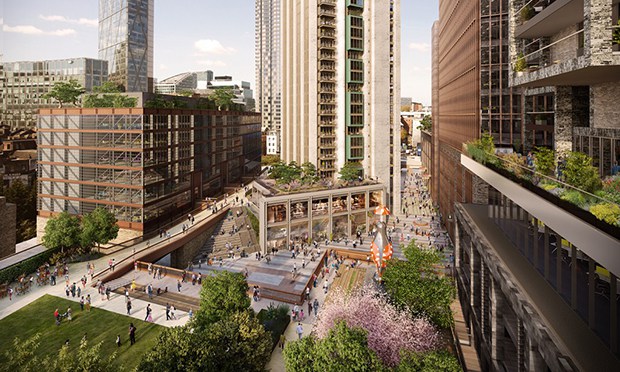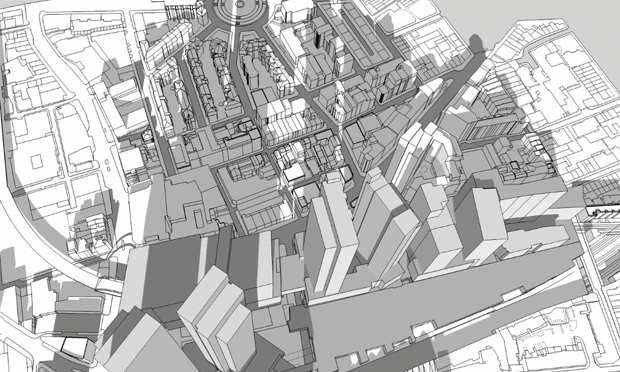Developers accused of ‘daylight robbery’ in Bishopsgate Goodsyard row

Adverse impact: an independent study claims Bishopsgate Goodsyard developers have ‘underplayed the value of loss of sunlight’ in their proposals. Photograph: Hammerson plc
The loss of natural light to homes will be greater than developers claim, should the controversial Bishopsgate Goodsyard scheme go ahead.
So says a damning new report by Dr Paul Littlefair, Principal Lighting Consultant at the Building Research Establishment (BRE), a building science centre.
Plans by developers Hammerson and Ballymore to throw up seven tower blocks – one of which will stand at 48 storeys high – have outraged residents and campaigners, 11,000 of whom have signed an online petition asking Tower Hamlets and Hackney Councils, Boris Johnson and the Greater London Authority to reject the current scheme outright.
Protesters say the £800m development would overshadow swathes of the neighbouring Boundary Estate and surrounding area.
Residents’ association JAGO Action Group commissioned an independent report to examine the developers’ daylight assessment.
In his report, Dr Littlefair states: “In my experience, I am aware of no other proposed development that has been predicted to have such a large effect on so many dwellings.”
The report’s preliminary findings have been seen by the Hackney Citizen but the full report was released to the public today (21 March).
In it, the ‘rights to light’ expert criticised the ‘Daylight and Sunlight Assessment’ carried out by Gordon Ingram Associates (GIA) on behalf of the developers.
Dr Littlefair claims some of GIA’s findings “spurious” and said they had “underplayed the value of loss of sunlight in their report”.
The report also finds that the GIA omitted from their assessment some homes “for which there would be significant reductions” in daylight.
“For some of the surrounding dwellings (3 Club Row, and properties in Wheler Street and Redchurch Street), GIA have cited the distance from the new development as a mitigating factor, implying that as the development is far away the loss of light will somehow be less noticeable.
“This is a spurious argument, as the data show that there would still be large losses of light. In fact the distance between some of the affected dwellings and the proposed development highlights its size and bulk and the large area it impacts.”
Commenting on concerns about the loss of light should the plans go ahead, David O’Donoghue of the More Light More Power campaign group said: “Even if this mega-development contained 100 per cent genuinely affordable housing it would still not be acceptable to darken the lives of so many other people.
“We want Boris to see the light, reject this proposal and take a look at the real alternatives, which could make the Goodsyard great.”

Aerial view: how the proposed towers could overshadow the surrounding area. Image: More Light More Power
‘No surprise’
Hackney Mayor Jules Pipe has added his voice to the objections to the scheme. He said in a statement: “We know these enormous towers would destroy the heart of Shoreditch and cast a shadow over hundreds of nearby homes and businesses.
“That this new research suggests the loss of light would be greater than the developers claim comes as no surprise and is yet another reason why the Mayor of London should reject this shoddy application,” said Mayor Pipe.
“It’s already been exposed that the developers overstated their build costs, understated their profits and offered far fewer affordable homes than was viable.”
The decision to approve or reject Hammerson and Ballymore’s proposals will be made by London Mayor Boris Johnson, who overrode Hackney and Tower Hamlets councils by ‘calling in’ the planning application last September.
A date for the public hearing has not been set.
Hammerson and Ballymore and Tower Hamlets Mayor John Biggs have been approached for comment.
